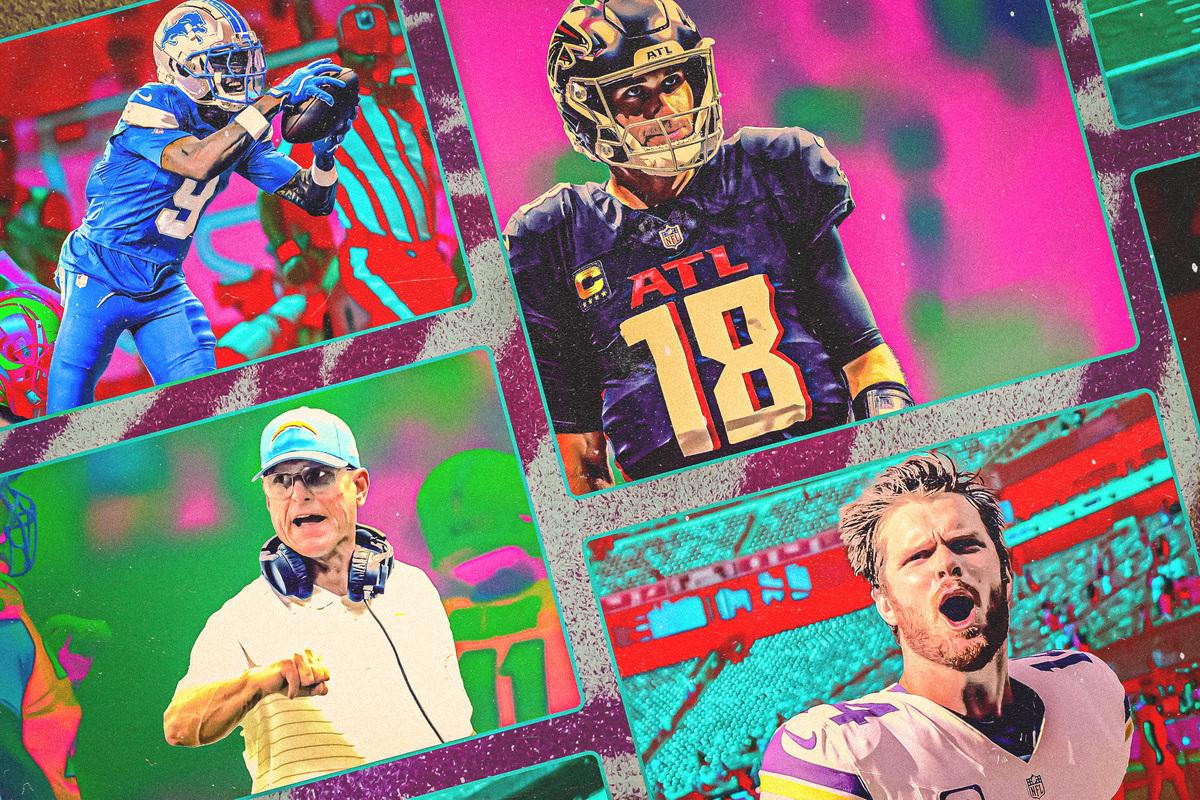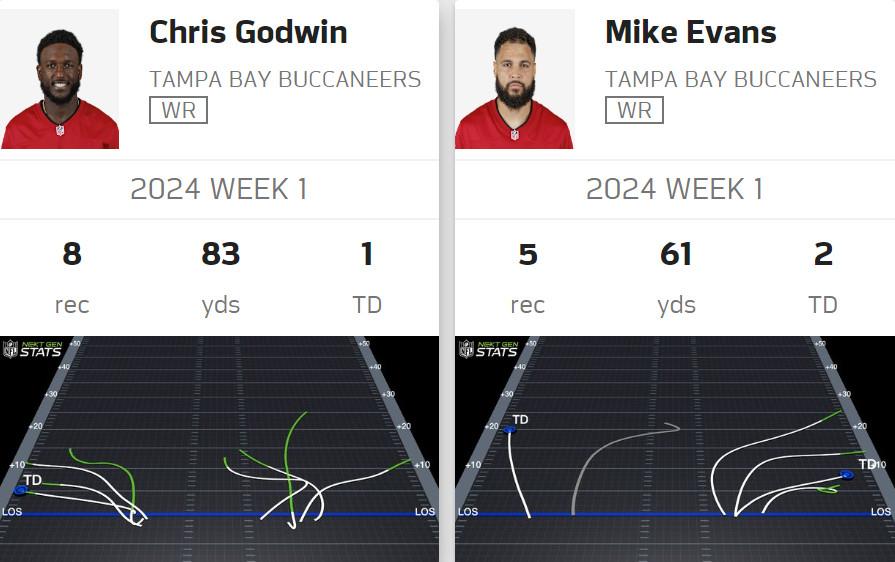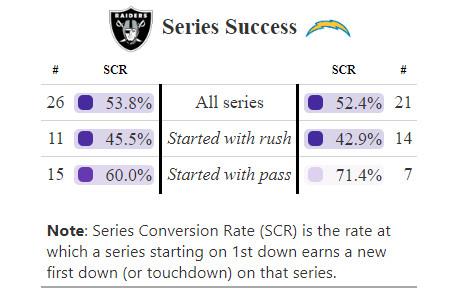
A responsible NFL analyst would advise against drawing conclusions from small sample sizes. But with just one week of results to work with, we don’t have much of a choice. The opening games of the 2024 NFL season provided us with several surprising and noteworthy developments—like Sam Darnold being good at football and the Buccaneers offense looking like world-beaters—so let’s try to determine which of those were signs of things to come and which were just false flags.
Is Buccaneers offensive coordinator Liam Coen the NFL’s next genius play caller?
As expected, the NFL’s leader in offensive efficiency through one week is the Tampa Bay Buccaneers, and Baker Mayfield is at the top of the league’s passing charts, having completed 24 of 30 passes for 289 yards and four touchdowns against the Commanders. Dave Canales, who now has the misfortune of coaching the Panthers, was given credit for turning around Mayfield’s career and getting decent play out of this Bucs offense last season. But this unit, which brought back many of the same players, looks even better under new offensive coordinator Liam Coen.
Coen hails from Sean McVay’s coaching tree. He served as the Rams’ offensive coordinator during their brutal 2022 season, in which Matthew Stafford went down with an injury and Los Angeles had to start a combination of John Wolford, Bryce Perkins, and Mayfield (who was at the lowest point of his career). Because of that, Coen didn’t get the immediate McVay bump that other Rams offensive coordinators have parlayed into head coaching gigs. Instead, Coen went back to his previous job coordinating Kentucky’s offense. He did well enough there to earn another shot at the NFL in Tampa. And if he can sustain the success we saw in Week 1, it won’t be long before Coen joins the long list of former McVay assistants at the helms of NFL teams.
Before we give Coen his “Scheme Lord” honors, though, we have to account for the fact that Tampa Bay was going up against, perhaps, the worst defense in the league in Washington. Outside of the interior defensive line, this Commanders unit doesn’t have much going for it—and Dan Quinn isn’t a defensive coach who elevates his talent through creative play-calling and sharp game-planning.
That was on full display on Sunday afternoon. It’s hard to judge a defensive game plan when you’re not sitting in on team meetings, but a sure sign of a bad plan is when the opposing offense is able to repeatedly find success using just a few concepts. That’s what we saw out of the Bucs. Mayfield continuously threw out-breaking routes to the perimeter or short routes behind the line of scrimmage, and the Commanders defense did not adjust. Mayfield threw to receivers running “out” or “corner” routes on nearly half of his attempts, per TruMedia. In 2023, NFL quarterbacks targeted receivers running those routes on just about 23 percent of pass attempts. Mayfield nearly doubled that number on Sunday. You can see the heavy preference for out-breakers on these route charts for Mike Evans and Chris Godwin.

Coen did a fantastic job of breaking Washington’s coverage rules and creating easy, in-rhythm throws for Mayfield, but future opponents won’t make it so easy.
The other key feature of Tampa Bay’s big performance will also be harder to replicate against better teams: the short passing game. On 11 throws aimed at or behind the line of scrimmage, Mayfield averaged 10.7 yards per attempt and 0.58 expected points added per play (both of which led the league), and he produced an explosive play on a whopping 27.3 percent of those passes (which also led the league). To put those numbers into perspective, the NFL average on those plays in Week 1 was 4.4 yards per attempt, minus-0.26 EPA per play, and a 5.1 percent explosive play rate, per TruMedia. If the Bucs can sustain that level of efficiency throughout the season, forget the “Scheme Lord” honors and a head coaching gig; we should just put Coen in Canton next summer.
So let’s wait a week before jumping on the Bucs-Baker-Coen bandwagon. Tampa Bay faces Detroit this week, and the Lions defense, with that pass rush and secondary, will offer this team its first legitimate test.
Is Kirk Cousins washed up?
When you pay $180 million for the Kirk Cousins experience, you expect to get the full Kirk Cousins experience—and Falcons fans did not get that in Sunday’s 18-10 loss to the Steelers. Cousins is the ultimate system quarterback. There’s a reason why he’s always seemed to be Kyle Shanahan’s dream partner in crime. He’s the guy who wants to get under center (many quarterbacks prefer shotgun) and run those play-action passes the coaches spent so much time setting up (many other quarterbacks hate turning their backs to the defense on the play fake). You don’t sign Cousins to line up in the gun and call dropback passes. You put the big goof under center and dial up some goddamn play fakes.
Now, you’re probably thinking: Surely Atlanta ran some of that against Pittsburgh! You’d be wrong. Cousins attempted one pass from under center on Sunday, and it was a spike to stop the clock. He didn’t use play-action on a single dropback. I nearly emailed the TruMedia admins to report the mistake, but a review of the tape confirmed that those numbers are correct.
That is more concerning than the ugly stat line Cousins produced—16-of-26 for 155 yards, one touchdown, and two interceptions—and it might be a sign that he’s struggling to move after last season’s Achilles injury. Dropbacks from under center require more mobility, as do the play-action boots Cousins has run throughout his career. Head coach Raheem Morris says there is no correlation between the play-calling and Cousins’s health. If that’s true, I have some questions for first-year offensive coordinator Zac Robinson, who called a rather predictable game against the Steelers.
This is not a viable approach with any quarterback. And it’s certainly not a viable approach for an offense that’s quarterbacked by Cousins. If it continues, the calls for Michael Penix Jr. to replace the $180 million man will only get louder. The play-calling splits are alarming, to say the least. I don’t think I’ve ever seen a team go an entire game without calling a play-action pass. Until Atlanta starts running the offense this quarterback and offensive coordinator are known for, it’ll be hard to believe that Cousins is 100 percent.
Has Jim Harbaugh already established the damn run in Los Angeles?
If you caught only the highlights of the Chargers’ 22-10 win over the Raiders, you might have come away from Sunday thinking that Harbaugh and offensive coordinator Greg Roman have already transformed the Chargers into a smashmouth, run-first unit. The box score, which shows L.A. ringing up 176 yards on 27 carries, backs that up. And J.K. Dobbins’s two big runs to help close out the win seemed to confirm it. But a deeper look at the Chargers’ run game production tells a different story.
The big runs by Dobbins, which came in short-yardage situations, accounted for 106 rushing yards, and Justin Herbert netted 6 yards on a scramble and a few kneel downs. The early-down run game, which sets the table for the passing game in Roman’s offense, was useless. The Chargers started with runs on 14 of 21 series of downs, per RBSDM.com. They converted those series into first downs only 42.9 percent of the time, compared to a 71.4 percent conversion rate when starting with a pass.

The idea behind building a run-first offense was to make Justin Herbert’s job easier, but the approach had the opposite effect on Sunday. While the Chargers quarterback played efficient football on early downs, most of his passing attempts came in obvious pass situations.
Justin Herbert Rush/Pass Down Splits Vs. the Raiders
And though tackles Rashawn Slater and Joe Alt played well, the offensive line as a unit did not. The Raiders generated a lot of quick pressure and unblocked rushers on Sunday. Herbert’s average time to pressure for the game was 2.4 seconds, per TruMedia. The league average is 2.9 seconds. And outside of rookie Ladd McConkey, the receiving corps did not shine either. Quentin Johnston and Josh Palmer both had big drops that ended drives, including on this play, which should have resulted in a touchdown.
Deficiencies in pass protection and the receiving corps are highlighted when the defense knows a pass is coming. The pass rushers can fire off the line at the snap. The defense can put its best coverage players out on the field and call more intricate coverages. And most of Herbert’s attempts came in those situations. The Chargers don’t have the personnel to sustain this kind of approach without running the ball effectively on first down.
Harbaugh’s preferred brand of offense does grind an opponent down eventually, as we saw in the second half of the Raiders game. The run game churned out more productive gains as the game went on, and the Chargers closed the win out on the ground. But better opponents will not provide such a margin for error. Most would have blown that game out in the first half and put L.A. in even more pass-first scenarios. That may not happen against the Panthers next week, but this setup won’t cut it against the Chiefs at the end of the month. That’s when we’ll find out how much progress Harbaugh and this offense have really made.
Is Jameson Williams’s breakout in Detroit real?
The 2023 Lions offense was good enough to win a championship. If the defense had capitalized on several opportunities—or just stopped Brock Purdy from scrambling for a couple of first downs—Detroit would have made its first appearance in the Super Bowl. But even if Detroit’s offense was already championship ready, there were some clear areas where it could have improved—one of which was the vertical passing game. The Lions have had no issues generating big pass plays under offensive coordinator Ben Johnson, but most of them have come on intermediate throws to the middle of the field. Even through all their success and production, the Lions didn’t have a true downfield threat on the perimeter.
The front office drafted Williams in 2022 to be that threat, but injuries and one teeny-tiny gambling scandal kept him off the field for 16 games over his first two seasons. That made it difficult for him to carve out a role in this highly productive offense, and he had just under 400 receiving yards to his name entering the 2024 season.
Welp, in one big night against the Rams, Williams increased his career receiving total by over 25 percent, hauling in five catches for 121 yards, including this long touchdown strike on a vertical route.
That’s one way to stop defenses from loading up the box to stop the run. Williams also had a few chunk plays on crossing routes (which he seems to run on two-times speed), so he was stretching the Rams defense vertically and horizontally throughout the night. After the long touchdown reception early in the third quarter, Los Angeles had two choices: die an instant death by letting Williams feast on single coverage on the outside or drop a second safety into the deep part of the field and suffer a slower (but more painful) death at the hands of the Lions’ offensive line and run game. Los Angeles took that second option in overtime, and Detroit marched right down the field for the game-winning score.
Williams didn’t catch a pass on that drive, but his influence was all over it. The Lions are hoping that will continue throughout the season and that it will prevent opponents from slowing down their run game, which remains the foundation of Johnson’s offensive scheme. As long as Williams is on the field and continues winning his one-on-one matchups, these Lions will be operating at a championship level. With how convincingly Williams was able to beat coverage against the Rams on Sunday, there’s no reason to believe he can’t keep this up.
Is Mike Zimmer back to being an elite defensive play caller?
Zimmer is back in the NFL, which is great news for fans of intricate blitzes. But it wasn’t great news for Deshaun Watson and a lowly Browns offensive line on Sunday. The Cowboys’ pass rush numbers from their 33-17 romp over Cleveland are jarring: 40 pressures, 18 hits, and six sacks.
The overall results were pretty good, too. The Browns averaged just 3.3 yards per play with a success rate of 25.6 percent on Sunday, the second-worst mark of the week, per TruMedia. Cleveland was behind the chains all day, which led to a lot of third-and-longs: a league-leading 12 of them, to be exact. Third-and-long is where Zimmer is at his most devious, and now that he has Micah Parsons to use as a roaming pass-rush threat who can line up anywhere on the front, the veteran defensive coordinator can draw up plenty of destructive pressures.
When we last saw Zimmer, he was coordinating a bad Colorado defense for Deion Sanders. Before that, a previously very good Vikings defense got old and bottomed out under his watch. But that had more to do with Minnesota’s personnel than Zimmer’s scheme, which fits right in with how the best modern defenses play: They stop the run without committing extra numbers in the box on early downs—only five teams played two-high coverages at a higher rate in Week 1, per TruMedia—and they play with the quarterback’s mind on third down via coverage disguises and gnarly blitzes. That’s been Zimmer’s plan of attack for decades. With Dallas, he has the personnel to run those schemes effectively.
I don’t think Zimmer ever truly lost his edge, so we can probably count on the Cowboys defense to keep this up. But beating up on flawed offenses was never a problem for Dallas when Zimmer’s predecessor, Dan Quinn, was calling the defense. Zimmer’s value will be determined in games against top teams. With Baltimore coming to Dallas in Week 3, we won’t have to wait long to confirm that the old coach still has it.
Is Sam Darnold’s second act starting in Minnesota?
No quarterback got off to a better start than Darnold on Sunday. Darnold opened the game going 13-for-13 and looking like the savior Vikings fans hoped he might be after rookie J.J. McCarthy went down with a season-ending knee injury in the summer. The next 11 attempts, though—which included a fluky interception but also a lucky dropped one—were a reminder that we can’t fall into Darnold’s thirst traps.
Darnold’s early highlights included several impressive downfield throws. But on each of them, he was provided a clear and concise read of the defense by his coach, Kevin O’Connell. Darnold simply had to read one defender and pick from one of two options based on which way that defender moved.
Most of those big plays came on early downs when defenses tend to play base zone coverages that are easier to manipulate with play design. That’s not to take anything away from Darnold—he still had to make high-quality throws—but O’Connell deserves his share of credit for the quarterback’s performance. The Vikings coach was not able to make life easier for Darnold in pass-heavy situations, though. Almost all of Darnold’s production came on first down, and his efficiency fell off significantly on later downs.
Sam Darnold Vs. the Giants, by Down
This was a good performance from Darnold, but we’ve seen this in the past. Before things went to shit for him in Carolina, Darnold got off to a hot start playing in an offense that featured Christian McCaffrey and plenty of schematic guardrails for the quarterback. Once McCaffrey got hurt and those guardrails malfunctioned, though, Darnold fell apart. Minnesota has a better (and deeper) support system around him, so he might be able to keep this up across a full season. Just don’t be surprised if the old Darnold shows up against defenses that won’t make things so easy on him.


